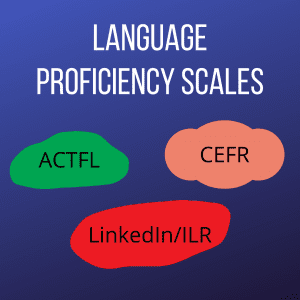‘Soy Bilingüe’ or ‘I Speak … a Little?’: Listing Language Proficiency Levels on a Resume

Whether you speak a lot of a language or a little, here’s a guide on listing your language proficiency levels on a resume.
Updated March 2023.
By: Katelyn Skye Bennett | Contributor for Let’s Eat, Grandma
Do you speak more than one language?
Well, good news! Language proficiency, if developed more than saying, “Jambo, Habari gani?” or “Je suis le grand fromage,” is usually worth noting on your resume.
Calling all first-gen Americans: You have an advantage here! Trabaja tu bilingüismo. List that multilingualism on all your resumes as “fluent” or “native.” You rock, and your future employers should know it.
Do you want more interviews?
More interviews. Job search progress. Career happiness.
Get the best tips delivered to your inbox plus a free resume critique!
For the rest of us who have learned languages over time, let’s dig a little deeper. Let’s ask the why, where, and how of listing languages on your resume.
When to list language proficiency on your resume

Photo by Kajetan Sumila on Unsplash
Should you list the additional language(s) you know on your resume? First, as always, consider relevance to the job you’re applying to.
Does the job in question require you to be fully bilingual or to know a particular language? Absolutely list your languages and proficiency levels on your resume (and LinkedIn profile, and cover letter). See the tips below to use accurate terms like “competent” if you’re intermediate or “fluent” if you’re a master.
But if you can’t hold a steady conversation or compose a document in those languages, pass. As you’ll see later, you don’t want to stretch it.
And if you’re truly talented but the job doesn’t require that knowledge, list your language skills on the resume but don’t focus on them. (We’ll get into the placement in a minute.)
I have a friend who knows how to say “I am so beautiful” in more languages than his fingers can count, but that doesn’t help him on the job. It would be a lie for him to say that he knows French, German, or Japanese. However, his proficiency in Mandarin and Korean, having grown up as an American overseas, is certainly worth noting!
Let’s use him as a case study: If he was applying for jobs working with Asian communities, he should center that knowledge throughout his resume. If he’s applying for jobs that don’t require that particular language set, he can simply list it as another skill.
Terminology tips for listing proficiency levels on your resume
So now you know when to include your language skills on your resume. Now, let’s talk about how to go about communicating your language proficiency levels.
When applying for a job that requires knowledge of a specific language, it’s common to include your language proficiency level on your resume. This can be a crucial piece of information for employers, as it helps them assess your ability to communicate effectively with clients, colleagues, and customers who speak that language. However, with different language proficiency scales in use and varying levels of self-assessment, it can be challenging to accurately convey your language skills on a resume.
Christian Eilers over at Zety shared this helpful list of terms you could choose to describe your level:
Advanced: native, fluent, proficient, advanced, mother tongue, upper-intermediate
Mid-range: intermediate, conversational, competent, professional
Beginner: elementary, beginner, basic, pre-intermediate, limited working proficiency

Again, beginner language skills aren’t usually worth noting. But if you’d fall in the “mid-range” or “advanced” area, terms or scales like these may be helpful to make sure you accurately portray your proficiency.
Pick the best proficiency term or scale ranking based on your region and what you think is easiest for the hiring staff to understand.
If you’re stuck trying to pick a level, you can take an assessment for one of the scales! (The ILR offers self-assessments for speaking, reading, and listening.)
What’s more, you can distinguish between reading, writing, and speaking on your resume, if need be. Maybe you’re fluent in writing but not speaking — that’s cool. Just make it clear.
Denis is a French bilingual agent at a call center. He grew up learning French overseas and can claim it as his native language; it’s clear the job was his for the taking.
However, anyone looking to join him in that position could qualify based on their proficiency in speaking the language competently over the phone and knowing how to write professionally in the language. For instance, if they have a mixed skillset, they could make that clear in their resume:
Languages: English (fluent) | French (speaking – fluent, writing – proficient)
It’s important to note, though, that you should never stretch or exaggerate your proficiency, even if the language is important to the job. Honesty on your resume will get you further in an interview. Just imagine if the hiring manager started speaking to you in the language you claim to know! Being straightforward initially will also make your hired life easier, as you’ll have to start using your language skills when you land the job.
Let’s Eat, Grandma suggests erring on the side of caution when choosing a fluency level term rather than trying to stretch it.
Language placement: Skills section or in its own category?
OK, trick question – Either one. Language acquisition is important enough to merit its own section on a resume, or you can work it into other sections. Again, it all depends on your proficiency and how important it is to the job you want.
For example, let’s say you’re applying for a job as a Marketing Manager, and Spanish fluency is a qualification in the job description. You can create a small section titled “Languages” that goes along with yourSkills section.And since bilingual is pertinent to the job you want, you can even mention it right in your summary as well.
However, if the languages you’re listing aren’t crucial to the job, and/or you need to save space, you can instead list your language skills on the resume as a bulleted category in your Skills section (you can also title the section “Skills and Languages.”) Just make sure it’s clearly labeled, like this:
That said, being multilingual is a huge and highly practical skill. You can communicate across cultures and borders. You can communicate via email or phone, in schools or in groups, at Eminem concerts (yes, ASL is a marketable language too!), in waiting rooms or at construction sites. You can be a written or verbal translator, with and on behalf of new Americans adjusting to this new land, and interpersonally in the office.
Note: You may notice “English” is missing in these examples. You could add that as well, if you want. But since your resume/cover letter are in English, and the job you’re applying for is in a country that speaks English as its official language, you don’t necessarily have to. Most hiring managers will understand.
I don’t know what your grandma thinks about bragging, but ours at Let’s Eat, Grandma thinks language skills are the kind of asset you should definitelyflaunt. If your skills are mature enough to merit it, give them their own space on your resume, and then back them up in the amount necessary to the job description.
Bilingual? Emphasize your superpower on your resume!
When it comes to showcasing language skills, the job description will determine how you arrange or focus your resume.
Some job postings will list something like “Bilingual in Spanish preferred.” In this case, don’t be afraid to list “bilingual” on your resume as a key descriptor for yourself in your summary of qualifications, like in our first example. You’ll also want to mention it your LinkedIn profile and your cover letter. You have a rare skill that they’re looking for, and you want them to know right away you can meet their needs.
And if you really want to show your fluency, and if speaking this language is really important to the job, get it into your bullet points.
Maybe you “taught English to 6 adult refugees and used Swahili to communicate with low-level learners” or “organized daily activities for 30 displaced first graders in French, Swahili, and Kinyarwanda in Masisi, DRC, amidst rebel conflict.”

Photo by National Cancer Institute on Unsplash
Perhaps you “managed 12 Vietnamese staff at an immigrant-owned business” or “created a clean and safe environment for three Arabic-speaking children” as their nanny. You’re providing concrete examples of your language proficiency levels in action.
You’re opening the door for the hiring manager to ask you questions that will allow you to shine.
By calling yourself bilingual in your summary of qualifications, weaving it into your bullet points, and explicitly listing your language proficiency levels on your resume, you’re creatively getting across the point that you have the necessary proficiency for a job that requires it.
And by listing your languages strategically for specific jobs that require knowledge of a certain language, you’re maximizing the seconds that the hiring manager will spend on your resume.
The bottom line is that fluency in more than one language is a career-boosting superpower. By knowing a second, third, fourth, or fifth language, you’re bettering your workplace and community by allowing for increased communication among coworkers, clients, students, and neighbors.
You are helping others be heard, and that is worth celebrating, including on your resume!
Want a second opinion on how you listed languages on your resume? Request a free resume critique here:
Better Resume.
Satisfying Career.
Happier You.


